Complete Solutions to SOLVED EXAMPLES of chapter RAY OPTICS AND OPTICAL INSTRUMENTS of Class 12 book with complete answers and questions
| Class 12 | PHYSICS |
| Chapter | RAY OPTICS AND OPTICAL INSTRUMENTS |
| MODERN PUBLICATION | SOLVED EXAMPLES |
| Number Of Questions | 100 |
| Academic Year | 2023-24 |
An object is kept in front of a spherical mirror and it is found that the image of height double to that of the object is formed by the mirror. If radius of curvature of spherical mirror is 40 cm then what are the possible positions of object in front of the mirror and which type of mirror is this?
View SolutionAssume that distance between the Earth and the Moon is `4 xx 10^(8)m`. Concave mirror of focal length 10 m is used to make the image of the Moon whose diameter is approximately 3,500 km. Calculate the diameter of image of the Moon.
View SolutionA car has a rear view mirror of radius of curvature 2 m. A motorcycle is approaching the car at `15 m//s`. If the car is stationary, how fast is the image of the bike approaching the car when the bike is 40 m away?
View SolutionIn the above example, how is the speed of the image affected if the motor bike comes closer to the car at (a) 30 m from the car (b) 20 m from the car?
View SolutionA `5 cm` long needle is placed `10 cm` from a convex mirror of focul length `40 cm`. Find the position, nature and size of image of the needle. What happens to the size of image when needle is moved farhter away from the mirror ?
View SolutionA 2.5 cm high candle flame is placed at a distance of 2.5 m from a wall. How far from the wall a concave mirror must be placed so that a 7.5 cm high inverted image of the flame is formed on the same wall? Also calculate the focal length of the mirror.
View Solutiona concave mirror of focal length `20 cm` and a convex mirror of focal length `15 cm` are placed `50 cm` apart, such that the two mirrors face eaachother. An object is placed exactly midway between them. Fing the nature and position of image formed by reflection first at concave mirror and then at convex mirror.
View SolutionAn image four times the size of an object is formed when the object is kept in front of a concave mirror of focal length 25 cm. Find the two possible distance of the object from the mirror.
View SolutionAn object is placed at a distance of 10 cm from a concave mirror. When the distance of object from the mirror is decreased to 6 cm, the image gets 2 times magnified than that in first case. Calculate the focal length of the mirror.
View SolutionIn the figure shown below, two objects A and B are placed one after another in front of a concave mirror of focal length 15 cm.

If the objects form image of same size, what should be the distance of object B from the mirror?
View SolutionRadius of curvature of concave mirror is R and a light ray is incident on it parallel to principal axis at a height h above the principal axis. Calculate distance of the point from pole of mirror where reflected ray intersects with principal axis.
View SolutionA ray of light of frequency 500 terahertz is passed through a liquid. If the wavelength of light measured inside the liquid is 450 nm, calculate the refractive index of the liquid.
View SolutionCalculate the frequency and wavelength of a light wave in a medium of refractive index 1.6. Given that the wavelength of light wave in air is `6,400 Å`.
View SolutionA ray of light strikes a plane boundary separating two media, medium 1 and medium 2, at an angle of `45^(@)`. Calculate the angle of refraction if the ray of light travels from medium 1 to medium 2. Given, refractive indices of medium 1 and 2 are 1.5 and 1.33 respectively.
View SolutionAt the bottom of a trough filled with water a rectangular glass slab is placed. A ray of light is incident on the water surface at an angle of `30^(@)` and enters the glass after passing through the water. What is the angle of refraction in glass? Given, refractive index of water is 1.33 and that of glass is 1.5.
View SolutionA ray of light is incident at an angle of `60^(@)` on one face of a rectangular glass slab of thickness `0.1 m`, and refractive index `1.5`.Calculate the lateral shift produced.
View SolutionAn object is placed at the bottom of a tank filled with liquid of refractive index 1.6. If the actual depth of the tank is 10 cm, what will be the apparent depth of the object?
View SolutionAn ink dot appeared to be raised by 1 cm when covered with a glass slab of thickness t cm. Calculate the value of t if the velocity of light in air and glass is `3 xx 10^(8) m//s` and `2 xx 10^(8) m//s`, respectively.
View SolutionTo determine the refractive index of a liquid experimentally, a mark is made on the beaker and a microscope was focussed on it, giving a reading of 3.42 cm. On pouring liquid till a height 2.68 cm inside the beaker, the reading of refocussed microscope is 3.38 cm. Calculate the refractive index of the liquid.
View SolutionA vessel has a 3-cm-thick bottom made of glass `(mu= 1.5)`. The vessel contains water `(mu = 1.33)` up to a depth of 6 cm and oil `(mu = 1.30)` up to a depth of another 7 cm. Find the apparent depth of vessel when viewed from above.
View SolutionCalculate the speed of light in a medium whose critical angle is `30^(@)`.
View SolutionCalculate the critical angle for a liquid in which speed of light is `1.2 xx 10^(8) m//s` assuming that a ray of light passes from this liquid into air.
View SolutionA ray of light travelling in air is incident on the surface of glass slab at an angle of `40^(@)`. If the ray is deviated through `18^(@)`, determine critical angle for the glass-air interface.
View SolutionWhen a glass slab is placed in air, its critical angle is `30^(@)`. What will be the critical angle when it is immersed in water whose refractive index is 1.33?
View SolutionConsider the figure given below. A ray of light is incident on one of the horizontal surfaces of glass slab at an angle of `60^(@)` and it just grazes along the adjacent vertical sides after refraction. Calculate the critical angle .

View SolutionIn Fig., find the maximum angle `i` for which light suffers total internal reflection at the vertical surface.
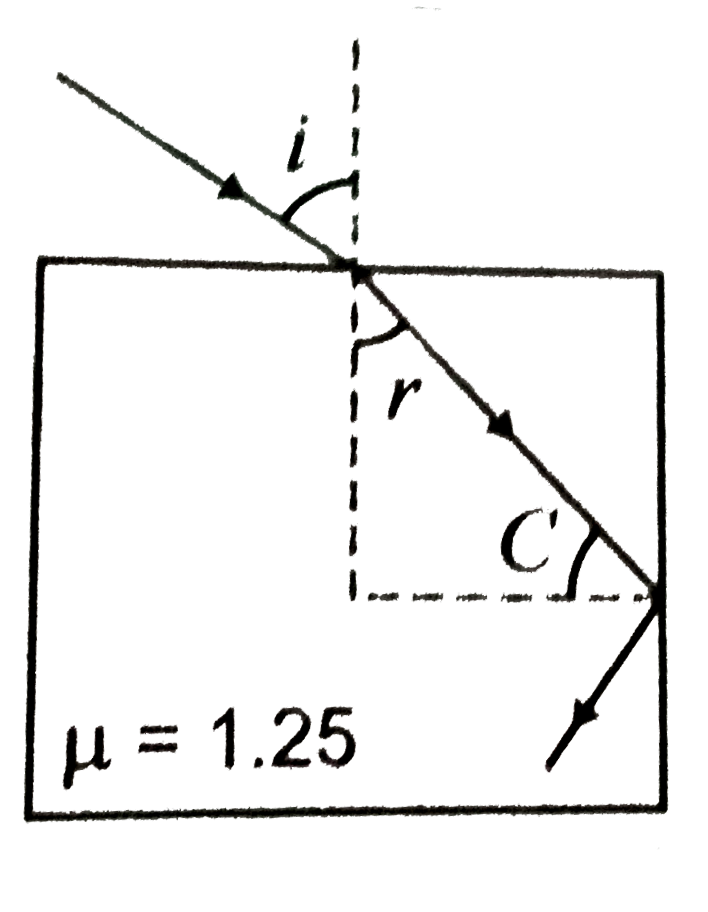 .
.
View SolutionWhat is the small index of refractive of the material of a right angled prism with equal sides for which a ray of light entering one of the sides normally will be totally reflected ?
View SolutionA point source of monochromatic light 'S' is kept at the centre of the bottom of a cylinder of radius `15.0 cm`. The cylinder contains water (refractive index 4//3) to a height of `7.0 cm`. Draw the ray diagram and calculate the area of water surface through which the light emerges in air.
View SolutionFor a fish under water, the entire outside view is confined within a cone. Draw an appropriate ray diagram for this and calculate the value of semi-vertical angle of the cone. Refractive index of water `=4//3`
View SolutionThe angle of incidence for a ray of light passing through an equilateral glass prism is equal to its angle of emergence. Also, the angle of emergence is `3//4` times the angle of prism. Calculate the angle of deviation and refractive index of prism's material.
View SolutionDetermine the speed of light through an equilateral prism for which a ray of light incident on it shows a minimum deviation of `30^(@)`.
View SolutionMinimum angle of deviation of a glass prism is equal to angle of prism. What is angle of prism?
View SolutionA ray of light is incident at an angle of `60^@` on the face of a prism having refracting angle `30^@.` The ray emerging out of the prism makes an angle `30^@` with the incident ray. Show that the emergent ray is perpendicular to the face through which it emerges and calculate the refractive index of the material of prism.
View SolutionA glass prism is made of a material of refractive index 1.5 and has a refracting angle of `60^(@)`. It is completely immersed in a liquid of refractive index 1.36. Calculate the angle of minimum deviation of the prism in this situation.
`(sin^(-1)0.55=33.37^(@))`
View SolutionA prism ABC of angle `30^(@)` has its face AC silvered. A ray of light incident at an angle of `45^(@)` at the face AB retraces its path after refraction at face AB and reflection at face AC . The refractive index of the material of the prism is
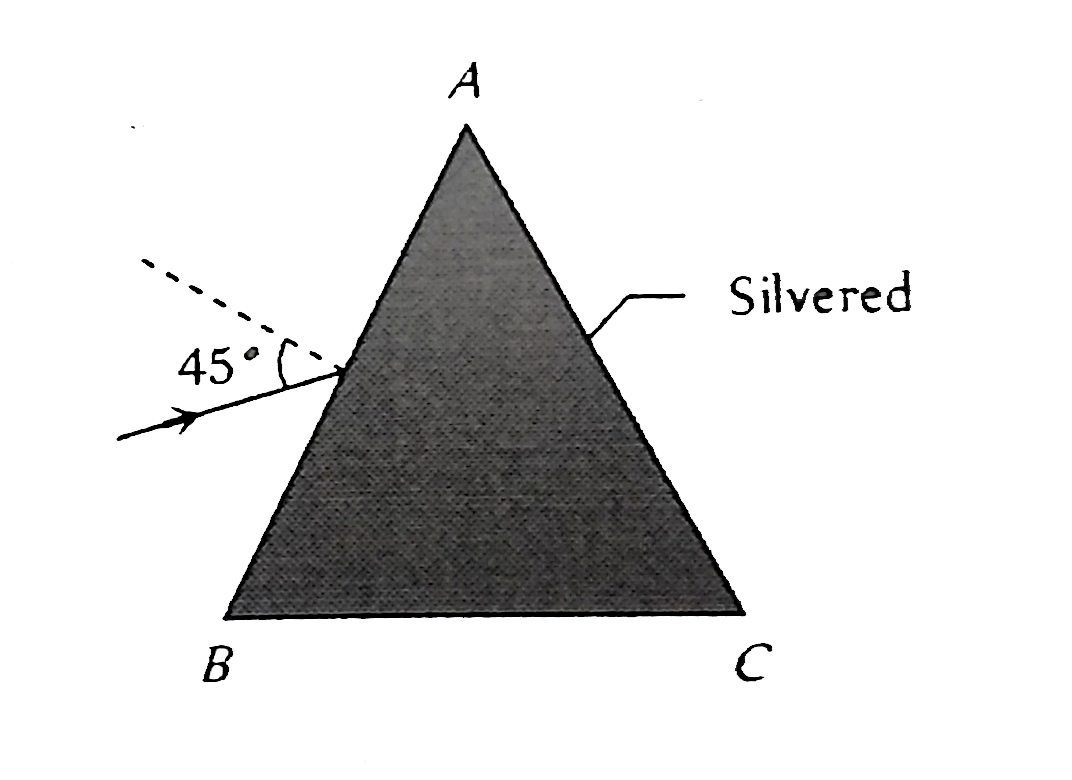
View SolutionAn equilateral glass prism of refractive index 1.5 is immersed in water. Find the angle of deviation produced when a ray of light is incident at `42^(@)` on one face of the prism.
(Refractive index of water = 1.33)
View SolutionFind the location and size of image for the situation shown in figure. Height of the object is 2 cm. Radius of curvature of surface is 25 cm and object is kept at a distance 50 cm from the surface.
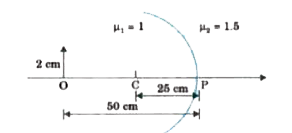
View SolutionIn the figure given below a hemisphere made of glass `(mu = 1.5)` is shown. Find the location of final image for the object O placed at a distance 40 cm from point P on the hemisphere. Consider outside medium as air.
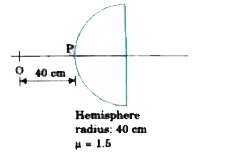
View SolutionA point source of light is placed in air, 100 cm away from a convex spherical surface, made of material of refractive index 1.5 and having radius of curvature = 20 cm. If the source emits light, at what position from the convex surface image will be formed?
View SolutionOne end of a cylindrical rod is grounded to a hemispherical surface of radius R = 30 mm. The refractive index of rod is 1.5. Find the position of the image placed on the axis of the rod at 10 cm from the pole.
View SolutionA glass sphere of diameter 20 cm is constructed with a material of refractive index 1.5. A beam of light strikes the sphere and converges at a point 40 cm behind the pole of a spherical surface. Find the position of the image.
View SolutionA curved surface of `mu= 1.5` forms a virtual image of an object which is placed in air at a distance of 15 cm from the surface. The image is formed at a distance of 60 cm, what is the radius of curvature of the curved surface? Also, calculate the power of curved surface and the two focal lengths of the surface.
View SolutionA mark placed on the surface of glass sphere is viewed through glass from an oppositely directed position. If the diameter of the sphere is 30 cm, locate the image of the mark. For glass, `mu = 1.5`

View SolutionA small air bubble in a sphere of glass with radius 4 cm appears to be 1 cm from the surface when observed along a diameter. Find the true positino of the air bubble.
View SolutionThere is a convex lens of focal length 20 cm. An object of height 3 cm is placed perpendicular to principal axis of lens at a distance 10 cm from the lens. Find the size of image.
View SolutionThere is one convex lens of focal length 40 cm. Where an object should be placed so that we get image of double the height of the object?
View SolutionFocal length of the concave lens is 40 cm. An object is kept at a distance 40 cm from the lens. What will be the location and magnification of image formed?
View SolutionThe graph in shows the variation of image distance (v) with object distance (u) in case of a lens. Find focal length of the lens. What is the nature of the lens, if image formed is real ?
 .
.
View SolutionAn illuminated object and a screen are placed `90 cm` apart. What is the focal length and nature of the lens required to produce a clear image on the screen twice the size of the object ?
View SolutionThe image obtained with a convex lens is erect and its length is `4` times the length of the object. If the focal length of lens is `20 cm`, calculate the object and image distances.
View SolutionA double convex lens has radii of curvature equal to 10 cm and 15 cm of the two faces. Given the focal length of lens is 12 cm, calculate the refractive index of glass.
View SolutionA biconcave lens is made of a material of refractive index `mu`. If the radius of curvature of each face of the lens is `(3)/(2)` times the focal length of lens, calculate value of `mu`.
View SolutionFind the radius of curvature of the convex surface of a plano-convex lens, whose focal length is 0.3 m and the refractive index of the material of the lens is 1.5.
View SolutionA biconvex lens has equal radii of curvature of 20 cm for each face and is made of material of refractive index 1.5. An object of 6 cm height is placed at a distance of 10 cm from the lens. Find the position, nature and size of the image.
View SolutionA double convex lens of glass `(mu = 1.5)` renders parallel rays coming from a distant source at a distance of 5 cm. If the radii of curvature are in the ratio `1:2`, calculate their individual values.
View SolutionA corverging lens has a focal length of `20 cm` in air. It is made of a material of refractive index `1.6`. If is immersed in a liquid of refractive index `1.3`, what will be its new focal length ?
View SolutionA thin lens with centres of curvature `C_(1) and C_(2)` is shown in the figure given below. If the refractive index of material of lens is 1.5, calculate the focal length in cm.

View SolutionRefractiven index of glass is `3/2` and that of water is `4/3` w.r.t. air. Calculate the ratio of focal length of a lens made of the glass when placed in water and air.
View SolutionA convex lens of material of refractive index 1.5 is immersed in a liquid of refractive index (i) 1.3 (ii) 1.6 and (iii) 1.5. What will happen to the focal length and nature of lens in all three cases?
View SolutionA concave mirror of radius R is kept on a horizontal table. Water (refractive index =mu.) is poured into it up to a height h. Where should an object be placed so that its image is formed on itself ?

View SolutionA convex lens is placed at a distance of 40 cm from a screen. A point source is placed at a distance of 60 cm from the screen on the same side of the lens. At this position of point-source, a circular spot of light of diameter equal to the lens is formed. Show the formation of image by a ray diagram. Up to what distance the source be displaced so that its clear image can be formed on the screen?
View SolutionAn arrangement of a concave and a convex lens is shown below. The focal length of the convex lens is 30 cm. Parallel rays coming from a distant source are focused on the screen after passing through the lenses. Calculate the focal length of the concave lens.

View SolutionIn the following ray diagram the positions of an object O, image I and two lenses `L_(1) and L_(2)` and a mirror M are given. The focal length of `L_(1)` is 10 cm. Find the focal length of `L_(2)`.

View SolutionFrom the ray diagram shown below, calculate the focal length of the other convex lens.
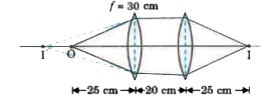
View SolutionA convex lens of focal length 10 cm is placed coaxially 5 cm away from a concave lens of focal length 10 cm. If an object is placed 30 cm in front of the convex lens, find the position of the final image formed by the combined system.
View SolutionA double convex lens of radius of curvature of each surface equal to 20 cm is made of glass of refractive index 1.5. Find the ratio of the powers of the lens when placed in air to its power when placed in water. Take refractive index of water = 1.33.
View SolutionTwo thin lenses of power +5 D and -2.5 D are in contact. What is the focal length of the combination ?
View SolutionAn arrangement of two lenses consists of a converging lens of focal length 40 cm placed coaxially in contact with another lens of unknown focal length. The combination behaves like a diverging lens of focal length 40 cm. Find the power and nature of the second lens.
View SolutionA thin convex lens made of glass of refractive index `3//2` has a power of 5 D. When it is immersed in a liquid of refractive index `mu`, it behaves like a divergent lens of focal length 1 m. Calculate the refractive index of the liquid.
View SolutionTwo coaxial thin lenses are placed in contact with each other and a small object is placed at a distance of 20cm from the combination of lenses. The focal length of each lens is 30 cm. What will be the distance between the object and the image when both the lenses are (i) convex (ii) concave
View SolutionFind the position of the image formed by the lens combination given in the following figure :

View SolutionAn equiconvex lens with radii of curvature of magnitude R each is put over a liquid layer poured on top of a plane mirror. A small needle, with its tip on the principal axis of the lens, is moved along the axis until its inverted real image coincides with the needle itself. The distance of the needle from the lens is measured to be 'a'. On removing the liquid layer and repeating the experiment the distance is found to be 'b'.
Given that the two values of distances measured represent the focal length values in the two cases, obtain a formula for the refractive index of the liquid.

View SolutionA convex lens is placed over a plane mirror. A pin is now positioned so that there is no parallax between the pin and its image formed by this lens-mirror combination. How can this observation be used to find the focal length of the convex lens? Give appropriate reasons in support of your answer.
View SolutionA convex lens of focal length `20 cm` is placed co-axially with a convex mirror of radius of curvature `20 cm`. The two are kept `15 cm` apart from each other. A point object is placed `60 cm` in front of the convex lens. Find the position of the image formed by the combination.
View SolutionA concave lens and a plane mirror re placed coaxially 10 cm apart. A point object is placed at a distance of 40 cm from the concave lens. The final image formed by the combination is located 30 cm behind the mirror. Calculate the focal length of the concave lens.
View SolutionThe far point of a myopic person is 120 cm in front of the eye. Calculate the power of the lens required to enable the person see distant object clearly.
View SolutionThe near point of a hypermetropic person is `50 cm` from the eye. What is the power of the lens required to enable him to read clearly a book held at `25 cm` from the eye ?
View SolutionCalculate the focal length of a lens used as simple microscope of magnifying power 20. Consider that the final image is formed at the least distance of distinct vision.
View SolutionA converging lens of focal length 5.0 cm is used as a magnifying glass. The near point of the observer is 25 cm from the eye. If the lens is held close to the eye, find the distance of object from the lens and its angular magnification.
View SolutionA magnifying glass is a combination of lenses of powers `+20 D and -5 D`. Calculate the magnifying power of the microscope, if the distance of distinct vision is 25 cm. Also, calculate the size of an object 3 cm high seen through the magnifying glass.
View SolutionA simple microscope of power 15 D is used to see an object. If the least distance of distinct vision is 25 cm, where should the object be placed so as to produce maximum angular magnification?
View SolutionA magnifying glass is rated 6X for a normal relaxed eye. For a relaxed farsighted eye whose near point is 50 cm, then what will be its magnifying power?
View SolutionA man with normal near point (25 cm) reads a book with small print using a magnifying glass : a thin convex lens of focal length `5 cm`.
(a) What are the closest and the farthest distances at which he can read the book when viewing through the magnifying glass ?
(b) What is the maximum and the minimum angular magnifications (magnifying powers) possible using the above simple microscope ?
View SolutionA figure divided into squares, each of size `"1 mm"^(2)`, is being viewed at a distance of 9 cm through a magnifying lens of focal length 10 cm, held close to the eye.
(i) Draw a ray diagram showing the formation of the image.
(ii) What is the magnification produced by the lens? How much is the area of each square in the virtual image?
(iii) What is the angular magnification of the lens?
View SolutionA compound microscope with an objective of `1.0 cm` focal length and an eye piece of `2.0 cm` focal length has a tube length of `20 cm`. Calculate the magnifying power of microscope is final image is formed at the near point of eye.
View SolutionTwo converging lenses of focal lengths 1.5 cm and 6 cm are chosen to design a compound microscope. It is desired to have a magnification of 25. Calculate the required separation between the objective and the eyepiece.
View SolutionFor a compound microscope, the focal length of eyepiece and objective lens is 5 cm and 1 cm, respectively. The length of the tube is 30 cm. If the final image is formed at infinity, calculate the magnifying power of the microscope.
View SolutionThe sum of focal lengths of the two lenses of a refracting telescope is 105 cm. The focal length of one lens is 20 times that of the other. Determine the total magnification of the telescope when the final image is formed at infinity.
View SolutionA telescope has objective and eyepiece lenses of focal lengths 150 cm and 5 cm, respectively. Calculate the magnifying power of telescope when the final image is formed
(a) at infinity and
(b) at the least distance of clear vision.
View SolutionA telescope has an objective of focal length 30 cm and an eyepiece of focal length 3 cm. It is used to focus on an object at a distance of 2 m. Calculate the separation between the objective and the eyepiece for seeing with relaxed eye.
View SolutionThe Moon is viewed by the telescope which consists of two lenses of focal lengths `5 m and 10 cm`. Calculate the angle subtended by the eye at the final image. The diameter of the Moon is `3.5xx10^(3) km` and its distance from the Earth is approximately `4xx10^(5) km`.
View SolutionA small telescope has an objective lens of focal length `150 cm` and and eye piece of focal length `5 cm`. If his telescope is used to view a `100 m` high tower `3 km` away, find the height of the final image when it is formed `25 cm` away from the eye piece.
View SolutionA terrestrial telescope has objective and eyepiece lenses of focal length 200 cm and 5 cm, respectively. The erecting lens has a focal length of 4.5 cm. Calculate the separation between the objective and the eyepiece. Also calculate the magnifying power of the telescope.
View SolutionA Galilean telescope obtains the erect final image by using a diverging lens of focal length 7.5 cm instead of an intermediate erecting lens. If the focal length of the objective is 150 cm, what is the separation between the objective and the eyepiece?
View SolutionA concave reflector of radius of curvature 110 cm is used by a reflecting type telescope. What will be the focal length of eyepiece required to obtain a magnification of 20?
View SolutionFocal lengths of a lens for violet, yellow and red colours are `f_(v), f_(y) and f_(r)` respectively. Calculate the dispersive power of the material of the lens.
View SolutionWhat is the angle of dispersion between red and violet colours produced by a flint glass prism of refracting angle `60^(@)`? Refractive indices of the given prism for red and violet colours are 1.622 and 1.663, respectively.
View SolutionWhite light is passed through a prism of refracting angle `6^(@)`. If the refractive indices for red and blue rays are 1.64 and 1.66 respectively, calculate the angle of dispersion between them.
View SolutionThe angle of minimum deviation for blue, red and yellow colours are `53^(@), 51^(@) and 52^(@)`, respectively when passed through a prism of angle `A = 60^(@)`. Calculate its dispersive power.
View SolutionThe refractive indices for violet, yellow and red colours for a flint glass prism are 1.634, 1.623 and 1.616. Calculate the dispersive power of the prism material.
View Solution
SOLVED EXAMPLES questions and complete solutions for chapter RAY OPTICS AND OPTICAL INSTRUMENTS of MODERN PUBLISHERS PHYSICS (HINGLISH) of Class 12
All Exercises from MODERN PUBLICATION Class 12 PHYSICS RAY OPTICS AND OPTICAL INSTRUMENTS
- CHAPTER PRACTICE TEST
- Conceptual Questions
- Higher Order Thinking Skills & Advanced Level (QUESTIONS WITH ANSWERS)
- NCERT (EXemplar Problems Obejective Questions) (Multiple Choice Questions (Type-I)
- NCERT (EXemplar Problems Obejective Questions) (Multiple Choice Questions (Type-II)
- NCERT (Exemplar Problems Subjective Questions) (Very Short Answer Type Questions)
- NCERT FILE SOLVED (TEXT BOOK EXERCISES)
- OBJECTIVE TYPE QUESTIONS (A. MULTIPLE CHOICE QUESTIONS)
- OBJECTIVE TYPE QUESTIONS (ASSERTION REASON TYPE QUESTIONS)
- OBJECTIVE TYPE QUESTIONS (B. MULTIPLE CHOICE QUESTIONS)
- OBJECTIVE TYPE QUESTIONS (C. MULTIPLE CHOICE QUESTIONS)
- OBJECTIVE TYPE QUESTIONS (D. MULTIPLE CHOICE QUESTIONS)
- OBJECTIVE TYPE QUESTIONS (INTEGER TYPE QUESTIONS)
- OBJECTIVE TYPE QUESTIONS (JEE (ADVANCED) FOR IIT ENTRANCE)
- OBJECTIVE TYPE QUESTIONS (JEE (MAIN) & OTHER STATE BOARDS FOR ENGINEERING ENTRANCE)
- OBJECTIVE TYPE QUESTIONS (MATCHING TYPE QUESTIONS)
- OBJECTIVE TYPE QUESTIONS (MATRIX MATCH TYPE QUESTIONS)
- PRACTICE PROBLEMS (1)
- PRACTICE PROBLEMS (10)
- PRACTICE PROBLEMS (11)
- PRACTICE PROBLEMS (2)
- PRACTICE PROBLEMS (3)
- PRACTICE PROBLEMS (4)
- PRACTICE PROBLEMS (5)
- PRACTICE PROBLEMS (6)
- PRACTICE PROBLEMS (7)
- PRACTICE PROBLEMS (8)
- PRACTICE PROBLEMS (9)
- Revision Exercises (Additional Questions)
- Revision Exercises (Fill in the Blanks)
- Revision Exercises (Long Answer Questions)
- Revision Exercises (Numerical Problems)
- Revision Exercises (Short Answer Questions)
- Revision Exercises (Very Short Answer Questions)
- SOLVED EXAMPLES
- Tough & Tricky (PROBLEMS)